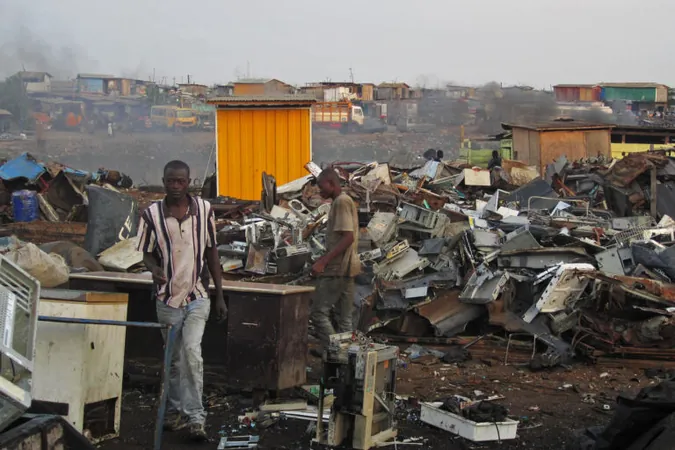
The Silent Crisis: How Our Obsession with Electronics Is Pushing the Planet to the Edge
2024-09-30
The Boom of Consumer Electronics
The consumer electronics industry has faced an unprecedented boom over the last few decades, with innovations ranging from advanced smartphones to ultra-slim laptops changing the way we live and work. By 2024, projections suggest that the consumer electronics market will exceed $809 billion and could surpass $1.4 trillion by 2034. But behind this shiny facade lies a troubling truth: the relentless pursuit of better technology comes at an alarming environmental cost.
Environmental Impact of Semiconductor Production
Experts warn that our insatiable appetite for high-powered devices like smart TVs, gaming consoles, and tablets could launch the planet into an environmental crisis. Ian Williams, an applied environmental science professor at the University of Southampton, emphasizes the staggering environmental toll associated with semiconductor production—the key ingredient powering our devices. The increasing demand for advanced semiconductors is creating what he terms an “environmental time bomb.”
Resource Consumption in Chip Manufacturing
The production process of everyday silicon chips is intricate, requiring vast quantities of energy and water. The chips are crafted from silicon, mined primarily from countries like China and the U.S., and require significant amounts of fossil fuels and chemicals, leaving an enormous carbon footprint. In fact, for every ton of silicon produced, about five tons of CO2 emissions are generated. Each manufactured chip can consume an astonishing amount of resources, including 800 grams of fossil fuels and 16,000 grams of water.
The Rise of AI and Its Demands
With the demand for semiconductors projected to reach $2 trillion by 2032, particularly driven by artificial intelligence (AI), the situation could grow dire. AI technologies require high-energy chips that consume massive amounts of power, raising concerns that data centers may soon require as much electricity as entire countries. Despite manufacturers asserting that innovations lead to energy efficiencies, the spiraling demand suggests a troubling trajectory.
Impacts of Chip Complexity
As we approach an era of higher chip complexity, the environmental impacts could intensify dramatically. While firms like Taiwan Semiconductor Manufacturing Company (TSMC) strive for greener practices, their operations remain water-intensive and heavily reliant on fossil fuels. Taiwan's tech industry is currently accountable for approximately 12% of the nation's greenhouse gas emissions, and significant droughts in recent years have exposed the precarious balance between water availability and semiconductor production.
Geopolitical Challenges and Opportunities
Geopolitical dynamics are complicating the semiconductor landscape as well. The U.S. has launched a concerted effort to reduce its reliance on Taiwanese manufacturers due to escalating tensions with China. This reshuffling of global chip production has created opportunities for other nations, like Costa Rica, aiming to attract tech investments. However, discussions around the environmental implications of this burgeoning industry remain sparse in such regions.
The Call for Sustainable Practices
With the rapid advances in electronics, we face a critical moment for action. Experts urge manufacturers to shift towards sustainable practices, emphasizing water conservation, effective waste management, and energy-efficient operations. Additionally, the need to redesign chips for easier recycling is becoming increasingly urgent to combat the rising tide of e-waste, which is now the fastest-growing waste stream globally.
The Responsibility of Consumers and Policymakers
As consumers, policymakers, and tech giants engage in broader discussions on climate and sustainability, we must critically examine whether our excitement for the latest gadgets is worth the hidden consequences threatening our planet's future. The decisions made today will determine not only the fate of the electronics industry but the environment we pass on to future generations.
Conclusion: Balancing Innovation and Environmental Responsibility
The question remains: can we balance our love for innovation with the essential responsibility of protecting our planet? The coming years may hold the answer, but only if we act decisively now.


 Brasil (PT)
Brasil (PT)
 Canada (EN)
Canada (EN)
 Chile (ES)
Chile (ES)
 España (ES)
España (ES)
 France (FR)
France (FR)
 Hong Kong (EN)
Hong Kong (EN)
 Italia (IT)
Italia (IT)
 日本 (JA)
日本 (JA)
 Magyarország (HU)
Magyarország (HU)
 Norge (NO)
Norge (NO)
 Polska (PL)
Polska (PL)
 Schweiz (DE)
Schweiz (DE)
 Singapore (EN)
Singapore (EN)
 Sverige (SV)
Sverige (SV)
 Suomi (FI)
Suomi (FI)
 Türkiye (TR)
Türkiye (TR)